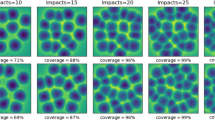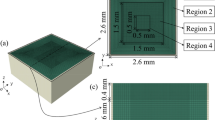Abstract
Tribo-peening is a unique derivative process of shot peening to produce functional surface with fully localized or distributed deformation induced by the impact and friction of activated formed and dispersed shot particles. This research paper discusses a methodology to develop a smart tribo-peening of surface functionalization with the aim of controlling tribo-peening operations through integration of sensors and taking advantage of information including data-driven simulation for shot peening process. A digital twin of high-fidelity computational model that simulates the tribo-penning process is hence designed to combine multi-sensory data insights, multiscale surface quality control, and physical processing capabilities. To drive the tribo-peening process, elementary areal surface representative (EASR) concept that involves multi-scale surface characterization is used to describe functionally the areal blasted surface and to create its representative digital twin. Results emphasize the ease with which tuning tribo-peening for surface functionalization may occur using digital twin concept. It shows also clearly that the design of shots operating under controlled impulsive loading is of considerable importance in tribo-peening process.
























Similar content being viewed by others
References
Hertz H (1881) Ueber die Berührung fester elatischs rKörper. J Reine Angew Math 92:156–171
Al-Hassani STS (1981) Mechanical aspects of residual stress development in shot peening. First International Conference on Shot Peening. Proceedings of the International Conference on Shot Peening (ICSP-l). Pergamon press, pp 583–602
Kobayashi M, Matsui T, Murakami Y (1998) Mechanism of creation of compressive residual stress by shot peening. Int J Fatigue 20(5):351–357. https://doi.org/10.1016/S0142-1123(98)00002-4
Abadie FX, Beaudonnet AL, Dixon J, Fader J, Fabre A, Barrallier L (2008) Application of ceramic shot for peening of automotive suspension coil springs. ICSP-10, Tokyo, Japan
Cabrero J, Levy B, Hancy R, Beaudonnet AL (2017) High density ceramic shot for peening application. ICSP13, Montréal, Canada
Guagliano M (2001) Relating Almen intensity to residual stresses induced by shot peening: a numerical approach. J Mater Process Technol 110(3):277–286. https://doi.org/10.1016/S0924-0136(00)00893-1
Meguid SA, Johnson W, Al-Hassani STS (1977) Some factors in the shot-peening and peen-forming processes. In: Tobias SA (ed) Proceedings of the Seventeenth International Machine Tool Design and Research Conference. Palgrave, London. https://doi.org/10.1007/978-1-349-81484-8_72
O'Hara P (1984) Developments in the shot peening process. Mater Des 5(4):161–166. https://doi.org/10.1016/0261-3069(84)90061-X
Lobanov LM, Garf EF (1998) Estimation of life of metal tubular structure connections at ultrasonic peening treatment of welded joint zone. J Constr Steel Res 46(1-3):431–432. https://doi.org/10.1016/S0143-974X(98)80071-0
Tönshoff HK, Kroos F, Marzenell C (1997) High-pressure water peening-a new mechanical surface-strengthening process. CIRP Ann 46(1):113–116. https://doi.org/10.1016/S0007-8506(07)60787-2
Bothen M, Kiesewetter L (1999) Process model for the abrasion mechanism during micro abrasive blasting (MAB) of brittle materials. In: Scholz-Reiter B, Stahlmann HD, Nethe A (eds) Process Modelling. Springer, Berlin, Heidelberg. https://doi.org/10.1007/978-3-642-60120-0_27
Lienert F, Gerstenmeyer M, Krall S, Lechner C, Trauth D, Bleicher F, Schulze V (2016) Experimental study on comparing intensities of burnishing and machine hammer peening processes. Proc CIRP 45:371–374. https://doi.org/10.1016/j.procir.2016.02.143
Ding K, Ye L (2006) 2 - Physical and mechanical mechanisms of laser shock peening. In: Woodhead Publishing Series in Metals and Surface Engineering. Woodhead Publishing, Laser Shock Peening, pp 7–46. https://doi.org/10.1533/9781845691097.7
Coniglio N, Mezghani S, El Mansori M, Cabrero J (2018) Effect of nano-penning surface texturing on self-cleaning function. Surf Coat Technol 353:126–134. https://doi.org/10.1016/j.surfcoat.2018.07.103
Gariepy A, Miao HY, Lévesque M (2017) Simulation of the shot peening process with variable shot diameters and impacting velocities. Adv Eng Softw 114:121–133. https://doi.org/10.1016/j.advengsoft.2017.06.011
Bagherifard S, Ghelichi R, Guagliano M (2012a) Numerical and experimental analysis of surface roughness generated by shot peening. Appl Surf Sci 258(18):6831–6840. https://doi.org/10.1016/j.apsusc.2012.03.111
Bagherifard S, Ghelichi R, Guagliano M (2012b) On the shot peening surface coverage and its assessment by means of finite element simulation: a critical review and some original developments. Appl Surf Sci 259:186–194. https://doi.org/10.1016/j.apsusc.2012.07.017
Taro M, Chaise T, Nélias D (2015) A methodology to predict the roughness of shot peened surfaces. J Mater Process Technol 217:65–76. https://doi.org/10.1016/j.jmatprotec.2014.10.016
Levy B, El Mansori M, Mezghani S, El Hadrouz M, Cabrero J, Beaudonnet AL (2020) Experimental study of single shot process: toward a surface state predictive tool. In: Itoh S., Shukla S. (eds) Advanced Surface Enhancement. INCASE 2019. Lecture Notes in Mechanical Engineering. Springer, Singapore. https://doi.org/10.1007/978-981-15-0054-1_5
El Mansori M, Mezghani S, Sabri L, Zahouani H (2010) On concept of process signature in analysis of multistage surface formation. Surf Eng 26(3):216–223. https://doi.org/10.1179/174329409X455412
Demirci I, Mezghani S, Yousfi M, Zahouani H, El Mansori M (2012) The scale effect of roughness on hydrodynamic contact friction. Tribol Trans 55(5):705–712. https://doi.org/10.1080/10402004.2012.694990
Chegdani F, Mezghani S, El Mansori M (2016) On the multiscale tribological signatures of the tool helix angle in profile milling of woven flax fiber composites. Tribol Int 100:132–140. https://doi.org/10.1016/j.triboint.2015.12.014
Belhadjamor M, El Mansori M, Belghith S, Mezlini S (2018) Anti-fingerprint properties of engineering surfaces: a review. Surf Eng 34(2):85–120. https://doi.org/10.1080/02670844.2016.1258449
Belhadjamor M, Belghith S, Mezlini S, El Mansori M (2017) Effect of the surface texturing scale on the self-clean function: correlation between mechanical response and wetting behavior. Tribol Int 111:91–99. https://doi.org/10.1016/j.triboint.2017.03.005
Zahouani H, El Mansori M (2017) Multi-scale and multi-fractal analysis of abrasive wear signature of honing process. Wear 376–377(Part A):178–187. https://doi.org/10.1016/j.wear.2017.01.087
Grieves M, Vickers J (2017) Digital twin: mitigating unpredictable, undesirable emergent behavior in complex systems. In: Kahlen FJ, Flumerfelt S, Alves A (eds) Transdisciplinary Perspectives on Complex Systems. Springer, Cham. https://doi.org/10.1007/978-3-319-38756-7_4
Shao G, Helu M (2020) Framework for a digital twin in manufacturing: scope and requirements. Manuf Lett 24:105–107. https://doi.org/10.1016/j.mfglet.2020.04.004
Haag S, Anderl R (2018) Digital twin - proof of concept. Manuf Lett 15:64–66. https://doi.org/10.1016/j.mfglet.2018.02.006
Kirk D (2008) The Shot Peener magazine 22(1)
Alizadeh Dehkharghani A (2016) Tuning Johnson-Cook material model parameters for impact of high velocity, micron scale aluminum particles. Dissertation, Boston, Massachusetts: Northeastern University
Meo M, Vignjevic R (2003) Finite element analysis of residual stress induced by shot peening process. Adv Eng Softw 34(9):569–575. https://doi.org/10.1016/S0965-9978(03)00063-2
Abaqus Analysis User’s Manual (2008) ABAQUS Analysis user’s manual version 6.8., Dassault Systemes
Li HZ, Wang J, Fan JM (2009) Analysis and modelling of particle velocities in micro-abrasive air jet. Int J Mach Tools Manuf 49(11):850–858. https://doi.org/10.1016/j.ijmachtools.2009.05.012
Miao HY, Larose S, Perron C, Levesque M (2009) On the potential applications of a 3D random finite element model for the simulation of shot peening. Adv Eng Softw 40:1023–1038. https://doi.org/10.1016/j.advengsoft.2009.03.013
Acknowledgements
The authors wish to express their thanks and gratitude to T. BALLARD, R&D intern-engineer, for his collaboration.
Author information
Authors and Affiliations
Contributions
Benjamin Levy: methodology, resources, investigation, data curation.
Mohamed El Mansori: supervision, conceptualization, methodology, writing—original draft, writing—review and editing.
Mourad El Hadrouz: conceptualization, methodology, investigation, data curation, writing—original draft, writing—review.
Sabeur Mezghani: conceptualization, methodology, data curation.
Anne-Laure Beaudonnet: conceptualization, methodology.
Julien Cabrero: conceptualization, methodology.
Availability of data and materials
Not applicable.
Corresponding author
Ethics declarations
Ethical approval
This material is the authors’ own original work, which has not been previously published elsewhere.
The paper is not currently being considered for publication elsewhere.
The paper reflects the authors’ own research and analysis in a truthful and complete manner.
The paper properly credits the meaningful contributions of co-authors.
The results are appropriately placed in the context of prior and existing research.
All sources used are properly disclosed (correct citation).
All the authors have been personally and actively involved in substantial work leading to the paper and will take public responsibility for its content.
Consent to participate
Not applicable.
Consent for publication
Not applicable.
Competing interests
The authors declare competing interests.
Additional information
Dedicated to Dr. S. Mezghani who supervised part of this Ph.D. work of B. Levy under the guidance of Prof. M. El Mansori. Dr. S. Mezghani passed away during the redaction of this research paper.
Publisher’s note
Springer Nature remains neutral with regard to jurisdictional claims in published maps and institutional affiliations.
Rights and permissions
About this article
Cite this article
Levy, B., El Mansori, M., El Hadrouz, M. et al. Smart tribo-peening process for surface functionalization through digital twin concept. Int J Adv Manuf Technol 114, 3695–3717 (2021). https://doi.org/10.1007/s00170-021-07143-x
Received:
Accepted:
Published:
Issue Date:
DOI: https://doi.org/10.1007/s00170-021-07143-x




